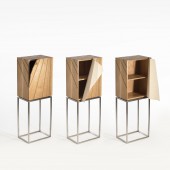Peel Cabinet by Leah K. S. Amick |
Home > Winners > #44387 |
 |
|
||||
| DESIGN DETAILS | |||||
| DESIGN NAME: Peel PRIMARY FUNCTION: Cabinet INSPIRATION: Peel’s inspiration came from a consideration of surfaces, their manipulation, and the expectations placed on an object. How can a surface create a moment of ooh and ah-ha? How would it feel to bend and break? How can this experience become a functional object? UNIQUE PROPERTIES / PROJECT DESCRIPTION: Peel is a freestanding cabinet featuring an unusual door that, rather than swinging on a hinge, peels open. A satisfying, tactile experience is created first as the plane of the door breaks away, folding back in segments, and then once again as the cover is gently pulled back into place, reverberating a short melodic scale. OPERATION / FLOW / INTERACTION: Designed to live in a home, the cabinet is scaled to fit against the wall in most any room. Angular grooves, repeated on three sides, break the surface of the cabinet; transecting the grain of the white oak box. The three patterned planes converge at the top left corner, where a conspicuous handle juts outward, enticing the approaching user. As the handle is pulled, the plane of the door breaks away, bending at the first groove and then the next. The door peels off the face of the cabinet and wraps around the side to tuck, neatly coiled, out of the way. The unembellished interior volume is divided by a single shelf, providing ample storage. When the cover is returned, magnets snap each segment progressively into place. Meeting the frame, each panel reverberates a higher note, climbing a short melodic scale. PROJECT DURATION AND LOCATION: Designing for Peel began in February 2014 and the construction of the cabinet body was completed in March 2014. The first iteration of the metal base was also completed in March 2014, but was recreated in April 2015. FITS BEST INTO CATEGORY: Furniture Design |
PRODUCTION / REALIZATION TECHNOLOGY: The body, constructed from white oak, sits on a lightly brushed, stainless steel base. Seven angular panels are laminated onto a heavy canvas to create the reverse effect of a tambour door, which is held in place by a series of neodymium magnets embedded within the wood. SPECIFICATIONS / TECHNICAL PROPERTIES: Width 460 mm x Depth 68 mm x Height 1320 mm TAGS: furniture, cabinet, white oak, door, woodworking, wood, metal, stainless steel, canvas RESEARCH ABSTRACT: A search for objects with a movement and interaction similar to the desired outcome led to the tambour door and the iPad Smart Cover. From this initial analysis, research was primarily conducted through experimentation with materials, mechanisms, and fabrication techniques. Through several tests laminating wooden segments onto a variety of materials, insight was gained into the process of creating a living hinge for Peel’s unique door. As the opening system was established, multiple iterations of physical models led to the size and shape of each door segment to ensure a satisfying interaction. CHALLENGE: There were several challenges involved in Peel’s creation, many of which were resolved through a full scale, functioning prototype, including the scale, proportions, and function of the piece. As the cabinet’s door is its main feature, the correct interaction between the opening system and user was key to its success. The configuration, size, and format of the front assembly was determined through trial and error with physical models. Placement of the magnets within the body and door was also crucial to the piece. A rough prototype led to the correct location and position of each magnet. ADDED DATE: 2016-01-14 20:34:06 TEAM MEMBERS (1) : IMAGE CREDITS: Image #1: Photographer Mark Johnston, Peel, 2015. Image #2: Photographer Mark Johnston, Peel, 2015. Image #3: Photographer Mark Johnston, Peel, 2015. Image #4: Creator Leah K. S. Amick, Peel, 2015. Image #5: Creator Leah K. S. Amick, Peel, 2016. |
||||
| Visit the following page to learn more: http://www.leahksamick.com | |||||
| AWARD DETAILS | |
 |
Peel Cabinet by Leah K. S. Amick is Winner in Furniture Design Category, 2015 - 2016.· Press Members: Login or Register to request an exclusive interview with Leah K. S. Amick. · Click here to register inorder to view the profile and other works by Leah K. S. Amick. |
| SOCIAL |
| + Add to Likes / Favorites | Send to My Email | Comment | Testimonials | View Press-Release | Press Kit |







